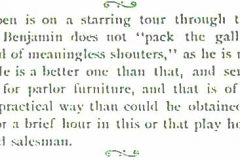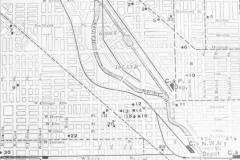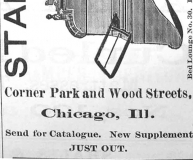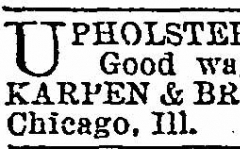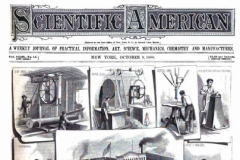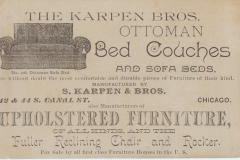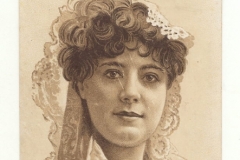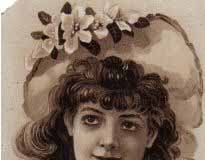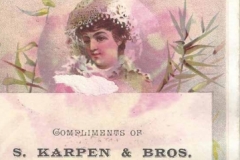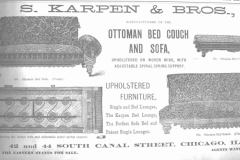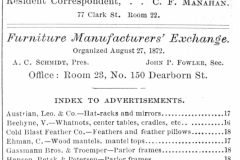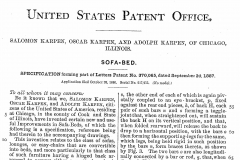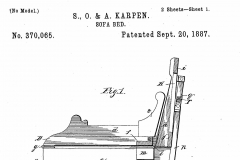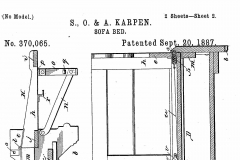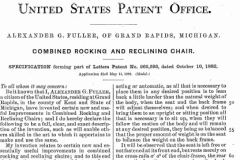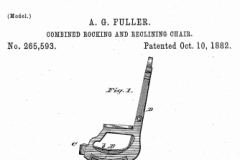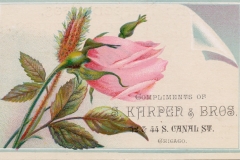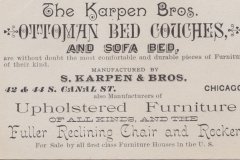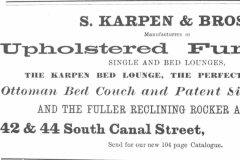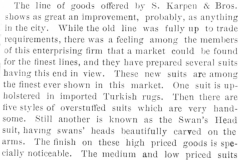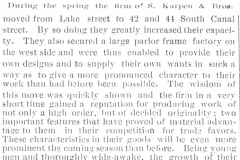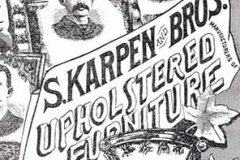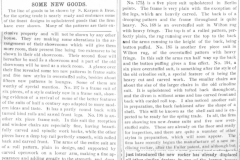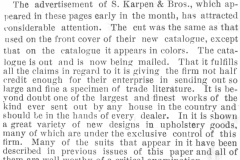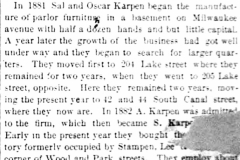Nine brothers in the Business: 1887-1888
Solomon Karpen understood from the beginning that there would be strength in having his eight brothers associated with him for the one purpose, joined as they were, not only by ties of family, but by tradition, common interests and the same ideals of workmanship. He enlisted one after another in the business, until all were finally part and parcel of it. Each brother in his turn entered the business as an apprentice and learned it from the lumber yard to the shipping platform. — Chicago Furniture Manufacturers Association. “The Story of Karpen.” Chicago: Chicago Furniture Manufacturers Association, August 26, 1930.
Solomon’s vision of all the nine brothers working together was being realized. The brothers shared the business responsibilities. Solomon was in charge of the factories[1] and purchased upholstery fabrics from the Eastern mills and importers”[2] [3] He made business trips to New York and Philadelphia several times a year, staying at the Imperial Hotel and the Bingham Hotel respectively. [4][5][6]
Oscar assisted Solomon and was in charge of the carpentry or “wood-working” department. [7] Ike moved up to being the upholstery factory foreman [8] and designer.[9] Adolph’s responsibilities were the office, showroom, and building. [10][11] William was the “credit man and has charge of the office force.”[12]
Other brothers joined the business. Benjamin left the cigar business to work as an agent for the company and then became a salesman in the west and northwest. A furniture trade journal wrote a favorable piece on Benjamin a few years later:
Leo began as a clerk at age 18. Julius worked part-time under William, the head bookkeeper and cashier, [13] while he was still a student at Northwest Division Chicago High School.[14][15] Mike continued as a traveling salesman.
1887
1887 was an important year in growth of Karpen Bros. In January it purchased the Chicago parlor furniture frame company of Stampen, Lee & Co.[16][17] The trade paper announced: “S. Karpen & Bros. have purchased the machinery, stock and furniture of the old factory of Stampen, Lee & Co., and will get into that market under the style of the Parlor & Lounge Frame Co.” [18]
Stampen, Lee & Co. had been established prior to 1880 with a factory at the corner of Wood and Park streets in the northwest area of the city. [19] It manufactured lounge frames, easy chairs, patented rocker and sofa frames.[20] In 1884, the Stampen, Lee Furniture Co. was formed with a capital stock of $50, 000, [21] but at the end of 1885, the company was reported to have dissolved, [22][23] and “quit its factory.”[24]
A trade paper commented on the new factory’s excellent location, 2.5 miles from the center of the city.[25] “Standing as it does immediately north of the route taken by the Logan Square branch of the Metropolitan elevated road and in the heart of a densely populated district of the west side, it is difficult to compute the vast number of people who annually have obtruded upon their attention the immense square brick building, surmounted by a sign in letters several feet high, proclaiming the name of the firm and the kind of business they carry on. Millions must every week, whether they are looking for it or not, see that sign and the factory it adorns, for it is one of the most conspicuous objects along the great west side route of travel to the northwestern section of the city.”[26]
An 1880 Article about a similar factory. (Scientific American, October 6,1880, 229.)
From that time, Karpen Bros. made the frames for its upholstered pieces.[28] [29][30] It employed about fifty or sixty “hands” or laborers in the frame factory.[31] The factory was well-situated on the Milwaukee Avenue street car line[32] in a section of the city filled with German-speaking immigrants. “Large manufacturers… obtained their own lumber for furniture construction, contracting for it to be brought in sailing vessels down the Chicago River, to their own yards.”[33] Since the factory was conveniently located a few blocks west of the Chicago River near Blackhawk Street and Goose Island, the lumber for the furniture frames arrived close to the factory. This new factory was located near the Karpen brothers’ homes.
A few months later, Karpen Bros. move to its new “warerooms” and upholstery factory at 42- 44 South Canal Street, between Madison and Washington, where they occupied four large floors.[34] The upholstery factory was located in the center of the furniture manufacturing area of the city,[35] “with about three times their former room.” Then about a 100 “hands” were “engaged in the production of parlor furniture, the Schrock Patent Ottoman Bed Couch, Karpen’s patent bed lounges and patent single lounges.” [36]
The company’s advertisements identified its marketing goals: “For Sale by all first class Furniture Houses in the U.S”[37] and “Agents wanted in every city.”[38] Its sales force grew to cover more regions of the country.[39] C.F. Blackman covered the Northwest, and W. F. Tenney traveled through the South. The Karpen salesmen covered the country bringing in substantial orders. Before 1890, Karpen handled their goods in the Pacific coast territory entirely through commission men, but “the success with which their salesmen met has decided them to cover the territory with their own men hereafter.”[40] It was Benjamin who often took extended trips to the Pacific Coast.[41][42][43] Mike still traveled in the West so that region was well covered. Sig (S. C.) Fish worked as its salesman in the East; he knew the business well because his family owned a retail furniture store in Chicago.[44]
The trade papers reported the salesmen’s comings and goings as they returned to Chicago for a few weeks and then went out to their territories. Excellent sales and large orders sent back to Chicago were often noted.
Like many other companies, used attractive cards to hand out to potential buyers. These cards have the same reverse sides.
The demand for Karpen furniture continued to grow. The trade papers reported: “Messrs. Karpen Bros., who are making some specialties in parlor goods, are about as hard run as any of the prominent firms here, having possibly a great number of unfilled orders on their books now than any other time;” [45] “a big demand for their specialties this fall;”[46] “in the midst of a big spring trade;”[47] “very busy, having all the trade they can handle;” [48] “nearly two months behind on their orders. Even their enlarged facilities are beginning to be severely tested.” [49]
Again in 1887, S. Karpen & Bros. exhibited at the Industrial Exposition. It had “a display of three ottoman lounges and sofa-beds, which, while it shows the many desirable features of the article to advantage, it is far overshadowed by the display the firm makes in their own showroom.”[50] The trade paper reporter was very critical of the event, however, concluding that “until the furniture manufacturers of this city are united in better shape than there seems any present prospect of, they had better let the Chicago Exposition severely alone.”[51]
In 1887, Salomon [sic], Oscar, and Adolph were issued their first patent. They patented a sofa-bed under U.S. Patent # 370,065, September 20, 1887. It was listed under “Index of Inventions” in the October 8, 1887 issue of Scientific American.[52]
Karpen Bros. added to its patented furniture line by obtaining the Fuller patent for a new reclining rocker from Alexander G. Fuller. “In general appearance it is like any other patent rocker, but it is so arranged that a person seated in it can without rising place it any desired angle and fasten it there and it can be entirely open or closed without getting out of it.”[54]
The reputation of Karpen Bros. continued to grow. The trade papers wrote in glowing phrases about “that enterprising firm of parlor furniture manufacturers.” [56]
In fewer than eight years, Solomon and his brothers had created a corporate presence, and their rapid rise did not go unnoticed: “They have had a remarkably successful career, and from a basement at the extreme end of Milwaukee Avenue graduated to large salesrooms on Lake Street and even larger on Canal Street”[58] A summary of the furniture trade published early in 1888 praised the firm’s decisions:
Karpen catalogs from the 1880s have not been located, but advertisements and articles in the trade journals described the typical late Victorian “suits” and other parlor pieces. Suits (suites) of furniture were the basic building blocks of all interiors. Interior designers did not exist as a profession. Architects would design houses, apartment buildings, and public buildings. Then it was left to the individual, with the help of the retail or department store salesmen, to fill those spaces. Buying a suite of furniture with an occasional additional chair or bench was believed to be the most feasible and safest strategy to achieve an aesthetically pleasing and coordinated environment.
Karpen Bros. produced many styles of suites in their frame factory. Many of the patterns were its exclusive property and were not shown by any other “house” or company.[59] The reporters described in detail the variety of frame styles and upholstery fabrics in production
Other articles described their line: “One suit is upholstered in imported Turkish rugs…still another is known as the Swan’s Head suit, having swans’ heads beautifully carved on the arms.” [60] “Corner chair 210 and chair 222 in particular are selling so fast that the firm are behind their orders for them.” [61] “Rep and haircloth were the favorite coverings, while tow was the usual material used in upholstering.[62]
Cover of S. Karpen & Bros.’ 1888 catalog with photographs of each brother. Top, l to r: Mike, Benjamin, William; Middle: Oscar, Solomon, Adolph; Bottom: Julius, Leo, Isaac.
It was a catalog cover that brought Karpen Bros. its most significant national attention and raised its name-recognition to a much higher level. Other furniture manufacturers featured photographs of their company’s founders (especially if they were members of the same family) in their advertisements. Most probably in 1888, Adolph, who was in charge of marketing, realized the unique advertising value of nine brothers working together in their own company. Expectations were high.
These expectations were surpassed. The color cover of the 1888 furniture catalogue caught the attention of the trade papers as they commented that “the faces on the first page represent the nine brothers of the Karpen family, all of whom are well informed in the furniture business.”[66] Inside the catalogue the dealer found 104 pages, each page 10 x 15 inches.[67] Reactions ranged from “handsome” to “one of the most tasty issued in Chicago this season” [68] to “the exquisite cuts so well represent the furniture they manufacture that one can order intelligently from the catalogue alone.”[69]
Advertisements with the nine brothers were used extensively. In some advertisements the text in the borders listed the Karpen Bros.’ product lines.
Adolph also understood that there had to be extra value attached to the headline. That they accomplished by using the catalog cover as its artwork in numerous full page and large-scale advertisements in the trade papers. The corporate culture of the nine brothers working together captured the interest of the industry. The trade paper copy was effusive: “The energy of the nine brothers composing the firm making itself felt in the trade.[72] “Karpen Bros. are cutting a very wide swath. Their trade this spring has been larger than ever before, and the styles of parlor furniture which they manufacture are meeting with the approval of the country at large, as well as commendatory words from their brother manufacturers in this city.[73] They are making better pieces than other first-class dealers, and it is being appreciated by the country.”[74]
The firm announced large sales from its new catalog, and it was well pleased with the expenditure. It “proved to them that something artistic and faithful in its story is money well spent.”[75] “S. Karpen & Bros. are very busy—more so than a year ago. Their new catalogue is in great demand and is already bringing in substantial results.” [76]
An 1887 “Historical Sketch of the Furniture Trade of Chicago” included the Karpen Bros. story:
- American Cabinet Maker and Upholsterer, Nov. 7, 1896, 13. ↑
- Furniture Worker, Dec. 10, 1897, 25. ↑
- Furniture World, Dec. 11, 1897, 18. ↑
- Furniture World, June 3, 1897, 15. ↑
- American Cabinet Maker and Upholsterer, May 29, 1897, 14. ↑
- Chicago Daily Tribune, Dec. 3, 1896.↑
- American Cabinet Maker and Upholsterer, Nov. 7, 1896, 13. ↑
- American Cabinet Maker and Upholsterer, July 28, 1894, 20. ↑
- American Cabinet Maker and Upholsterer, Nov. 7, 1896, 13. ↑
- American Cabinet Maker and Upholsterer, Nov. 7, 1896, 13. ↑
- American Cabinet Maker and Upholsterer, July 28, 1894, 20. ↑
- American Cabinet Maker and Upholsterer, Nov. 7, 1896, 13. ↑
- American Cabinet Maker and Upholsterer, July 28, 1894, 20. ↑
- “Julius Karpen Obituary,” Grand Rapids Furniture Record, Apr. 1907, 627. ↑
- John Leonard, ed., Book of Chicagoans: A Biographical Dictionary of Leading Living Men of the City of Chicago, (Chicago: Marquis & Co., 1905), 322-3. ↑
- Trade Bureau, Jan. 22, 1887, 16. ↑
- Company information: Sharon Darling, Chicago Furniture: Art, Craft, & Industry 1833-1983. (New York: W.W. Norton & Co. 1984), 67. ↑
- American Cabinet Maker and Upholsterer, Jan. 15, 1887, 12. ↑
- “ ‘The American Cabinet Makers’ Guide Map of Chicago Furniture Manufacturers and Kindred Trades,” American Cabinet Maker and Upholsterer, Aug. 21, 1880, 16-17. ↑
- American Cabinet Maker and Upholsterer, Aug. 21, 1880, 16-17. ↑
- Trade Bureau, Mar. 1, 1884, 24. ↑
- American Cabinet Maker and Upholsterer, Dec. 19, 1885, 13. ↑
- Trade Bureau, Mar. 11, 884, 24. ↑
- American Cabinet Maker and Upholsterer, Aug. 13, 1887, 23-4. ↑
- Chicago Daily Tribune, Mar. 26, 1899. ↑
- American Cabinet Maker and Upholsterer, Jan. 11, 1896, 21. ↑
- Sentinel Milwaukee, Sept. 30, 1887. ↑
- Trade Bureau, Apr. 30, 1887, 22. ↑
- Trade Bureau, Mar. 26, 1887, 17. ↑
- “Funeral Today on Coast for Mike Karpen,” Retailing Daily, New York, July 3, 1950, 7. ↑
- American Cabinet Maker and Upholsterer, Aug. 13, 1887, 23-4. ↑
- “ ‘The American Cabinet Makers’ Guide Map of Chicago Furniture Manufacturers and Kindred Trades,” American Cabinet Maker and Upholsterer, Aug. 21, 1880, 16-17. ↑
- Chicago Furniture Manufacturers Association, Chicago Furniture Manufacturers Association : 50 Forward Years 1888-1938 (Chicago: Chicago Furniture Manufacturers Association 1938), 7. ↑
- Neil Clark, “How Nine Brothers Built Up a $10,000,000 Business,” Forbes, Aug. 1, 1926, 10. ↑
- “ ‘The American Cabinet Makers’ Guide Map of Chicago Furniture Manufacturers and Kindred Trades,” American Cabinet Maker and Upholsterer, Aug. 21, 1880, 16-17. ↑
- American Cabinet Maker and Upholsterer, Aug. 13, 1887, 23-4. ↑
- Advertising card, Private collection, Emily C. Rose. ↑
- American Cabinet Maker and Upholsterer, June 4, 1887, 7; July 2, 1887, 20; July 16 1887, 6; July 30, 1887, 6; August 13, 1887, 23. ↑
- American Cabinet Maker and Upholsterer, Aug. 17, 1887, 11. ↑
- American Cabinet Maker and Upholsterer, Apr. 12, 1890, 18. ↑
- American Cabinet Maker and Upholsterer, Jan. 18, 1890, 13. ↑
- American Cabinet Maker and Upholsterer, June 14, 1890, 11. ↑
- “Funeral Today on Coast for Mike Karpen,” Retailing Daily, New York, July 3, 1950, 7. ↑
- American Cabinet Maker and Upholsterer, Oct. 26, 1889, 15; July 26, 1890, 16; Aug. 2, 1890, 14; Apr. 25, 1891, 14. ↑
- Trade Bureau, Mar. 26, 1887, 17. ↑
- Trade Bureau, Jan. 1, 1887, 15. ↑
- Trade Bureau, Feb. 26, 1887, 15. ↑
- American Cabinet Maker and Upholsterer, Apr. 30, 1887, 19. ↑
- American Cabinet Maker and Upholsterer, May 14, 1887, 11. ↑
- American Cabinet Maker and Upholsterer, Oct. 29, 1887, 15. ↑
- American Cabinet Maker and Upholsterer, Oct. 29, 1887, 15. ↑
- Scientific American, Oct. 8, 1887, 235. ↑
- American Cabinet Maker and Upholsterer, June 4, 1887, 7; July 2, 1887, 20; July 16 1887, 6; July 30, 1887, 6; Aug. 13, 1887, 23. ↑
- American Cabinet Maker and Upholsterer, Feb. 4, 1888, 11. ↑
- American Cabinet Maker and Upholsterer, Feb. 25, 1888, 16; Mar. 10, 1888, 7; Mar. 24, 1888, 7; Mar. 31, 1888, 20; May 12, 1888, 2; May 26, 1888, 2; June 2, 1888, 2; June 9, 1888, 2. Similar ads in Decorator and Furnisher Mar. 1888, 193; Apr. 1888, 2; May 1888, 38; June 1888, 74; July 1888, 40; Aug. 1888, 172; Similar ad: Trade Bureau, Aug 25, 1888, 32. ↑
- Trade Bureau, Jan.22, 1887, 16. ↑
- American Cabinet Maker and Upholsterer, Aug. 13, 1887, 23. ↑
- Trade Bureau, Jan. 22, 1887, 16. ↑
- American Cabinet Maker and Upholsterer, Feb. 4, 1888, 11. ↑
- American Cabinet Maker and Upholsterer, Aug. 13, 1887, 23. ↑
- American Cabinet Maker and Upholsterer, Sept. 24, 1887, 13. ↑
- Solomon Karpen in Carl Saunders, “They Called Us Crazy, but ─,”[An Interview with Sam Karpen] Furniture Manufacturer, September, 1930. (reprinted by S. Karpen & Bros, “Karpen Celebrates Half Century of Service.”), [1]. ↑
- American Cabinetmaker and Upholsterer, Mar. 23 1889, 22; May 18, 1889, 2. ↑
- American Cabinet Maker and Upholsterer, Apr. 14, 1888, 15; April 21, 1888, 3; May 5, 1888, 31. ↑
- American Cabinet Maker and Upholsterer, Mar. 3, 1888, 9; Apr. 7, 1888, 23. ↑
- Trade Bureau, Mar. 3, 1888, 19. ↑
- Trade Bureau, Feb. 4, 1888, 17. ↑
- Trade Bureau, Mar. 3, 1888, 19. ↑
- Trade Bureau, Mar. 31, 1888, 24 ↑
- American Cabinet Maker and Upholsterer [September and October- smaller sized advertisement.] Sept. 8, 1888, 22; Sept. 15, 1888, 24; Oct. 6, 1888, 24; Oct. 20, 1888, 20; Nov. 3, 1888, 20; Nov. 17, 1888, 19; Dec. 1, 1888, 21. ↑
- Trade Bureau, Mar. 10,1888, 7 = In color. The Trade Bureau, Apr. 7, 1888, 18. The Trade Bureau, Aug. 4, 1888, 15. ↑
- Trade Bureau, Mar. 31, 1888, 24 ↑
- Trade Bureau, Mar. 17, 1888, 19 ↑
- Trade Bureau, Mar. 31, 1888, 24 ↑
- Trade Bureau, Mar. 31, 1888, 24. ↑
- American Cabinet Maker and Upholsterer, Apr. 7, 1888, 16. ↑
